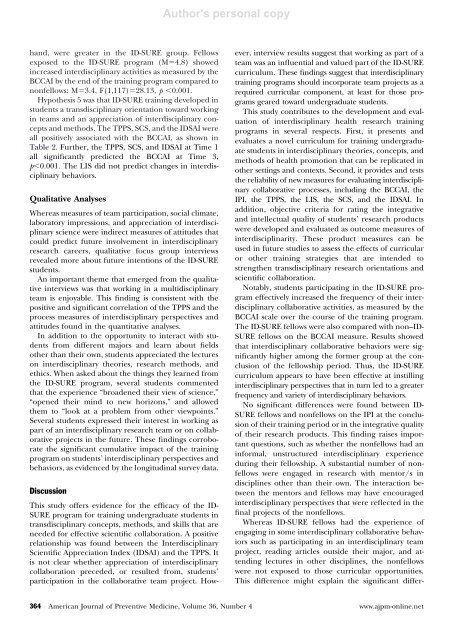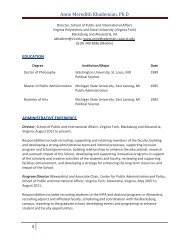Evaluating an interdisciplinary undergraduate training program in ...
Evaluating an interdisciplinary undergraduate training program in ...
Evaluating an interdisciplinary undergraduate training program in ...
You also want an ePaper? Increase the reach of your titles
YUMPU automatically turns print PDFs into web optimized ePapers that Google loves.
Author's personal copy<br />
h<strong>an</strong>d, were greater <strong>in</strong> the ID-SURE group. Fellows<br />
exposed to the ID-SURE <strong>program</strong> (M4.8) showed<br />
<strong>in</strong>creased <strong><strong>in</strong>terdiscipl<strong>in</strong>ary</strong> activities as measured by the<br />
BCCAI by the end of the <strong>tra<strong>in</strong><strong>in</strong>g</strong> <strong>program</strong> compared to<br />
nonfellows: M3.4, F(1,117)28.13, p0.001.<br />
Hypothesis 5 was that ID-SURE <strong>tra<strong>in</strong><strong>in</strong>g</strong> developed <strong>in</strong><br />
students a tr<strong>an</strong>sdiscipl<strong>in</strong>ary orientation toward work<strong>in</strong>g<br />
<strong>in</strong> teams <strong>an</strong>d <strong>an</strong> appreciation of <strong><strong>in</strong>terdiscipl<strong>in</strong>ary</strong> concepts<br />
<strong>an</strong>d methods. The TPPS, SCS, <strong>an</strong>d the IDSAI were<br />
all positively associated with the BCCAI, as shown <strong>in</strong><br />
Table 2. Further, the TPPS, SCS, <strong>an</strong>d IDSAI at Time 1<br />
all signific<strong>an</strong>tly predicted the BCCAI at Time 3,<br />
p0.001. The LIS did not predict ch<strong>an</strong>ges <strong>in</strong> <strong><strong>in</strong>terdiscipl<strong>in</strong>ary</strong><br />
behaviors.<br />
Qualitative Analyses<br />
Whereas measures of team participation, social climate,<br />
laboratory impressions, <strong>an</strong>d appreciation of <strong><strong>in</strong>terdiscipl<strong>in</strong>ary</strong><br />
science were <strong>in</strong>direct measures of attitudes that<br />
could predict future <strong>in</strong>volvement <strong>in</strong> <strong><strong>in</strong>terdiscipl<strong>in</strong>ary</strong><br />
research careers, qualitative focus group <strong>in</strong>terviews<br />
revealed more about future <strong>in</strong>tentions of the ID-SURE<br />
students.<br />
An import<strong>an</strong>t theme that emerged from the qualitative<br />
<strong>in</strong>terviews was that work<strong>in</strong>g <strong>in</strong> a multidiscipl<strong>in</strong>ary<br />
team is enjoyable. This f<strong>in</strong>d<strong>in</strong>g is consistent with the<br />
positive <strong>an</strong>d signific<strong>an</strong>t correlation of the TPPS <strong>an</strong>d the<br />
process measures of <strong><strong>in</strong>terdiscipl<strong>in</strong>ary</strong> perspectives <strong>an</strong>d<br />
attitudes found <strong>in</strong> the qu<strong>an</strong>titative <strong>an</strong>alyses.<br />
In addition to the opportunity to <strong>in</strong>teract with students<br />
from different majors <strong>an</strong>d learn about fields<br />
other th<strong>an</strong> their own, students appreciated the lectures<br />
on <strong><strong>in</strong>terdiscipl<strong>in</strong>ary</strong> theories, research methods, <strong>an</strong>d<br />
ethics. When asked about the th<strong>in</strong>gs they learned from<br />
the ID-SURE <strong>program</strong>, several students commented<br />
that the experience “broadened their view of science,”<br />
“opened their m<strong>in</strong>d to new horizons,” <strong>an</strong>d allowed<br />
them to “look at a problem from other viewpo<strong>in</strong>ts.”<br />
Several students expressed their <strong>in</strong>terest <strong>in</strong> work<strong>in</strong>g as<br />
part of <strong>an</strong> <strong><strong>in</strong>terdiscipl<strong>in</strong>ary</strong> research team or on collaborative<br />
projects <strong>in</strong> the future. These f<strong>in</strong>d<strong>in</strong>gs corroborate<br />
the signific<strong>an</strong>t cumulative impact of the <strong>tra<strong>in</strong><strong>in</strong>g</strong><br />
<strong>program</strong> on students’ <strong><strong>in</strong>terdiscipl<strong>in</strong>ary</strong> perspectives <strong>an</strong>d<br />
behaviors, as evidenced by the longitud<strong>in</strong>al survey data.<br />
Discussion<br />
This study offers evidence for the efficacy of the ID-<br />
SURE <strong>program</strong> for <strong>tra<strong>in</strong><strong>in</strong>g</strong> <strong>undergraduate</strong> students <strong>in</strong><br />
tr<strong>an</strong>sdiscipl<strong>in</strong>ary concepts, methods, <strong>an</strong>d skills that are<br />
needed for effective scientific collaboration. A positive<br />
relationship was found between the Interdiscipl<strong>in</strong>ary<br />
Scientific Appreciation Index (IDSAI) <strong>an</strong>d the TPPS. It<br />
is not clear whether appreciation of <strong><strong>in</strong>terdiscipl<strong>in</strong>ary</strong><br />
collaboration preceded, or resulted from, students’<br />
participation <strong>in</strong> the collaborative team project. However,<br />
<strong>in</strong>terview results suggest that work<strong>in</strong>g as part of a<br />
team was <strong>an</strong> <strong>in</strong>fluential <strong>an</strong>d valued part of the ID-SURE<br />
curriculum. These f<strong>in</strong>d<strong>in</strong>gs suggest that <strong><strong>in</strong>terdiscipl<strong>in</strong>ary</strong><br />
<strong>tra<strong>in</strong><strong>in</strong>g</strong> <strong>program</strong>s should <strong>in</strong>corporate team projects as a<br />
required curricular component, at least for those <strong>program</strong>s<br />
geared toward <strong>undergraduate</strong> students.<br />
This study contributes to the development <strong>an</strong>d evaluation<br />
of <strong><strong>in</strong>terdiscipl<strong>in</strong>ary</strong> health research <strong>tra<strong>in</strong><strong>in</strong>g</strong><br />
<strong>program</strong>s <strong>in</strong> several respects. First, it presents <strong>an</strong>d<br />
evaluates a novel curriculum for <strong>tra<strong>in</strong><strong>in</strong>g</strong> <strong>undergraduate</strong><br />
students <strong>in</strong> <strong><strong>in</strong>terdiscipl<strong>in</strong>ary</strong> theories, concepts, <strong>an</strong>d<br />
methods of health promotion that c<strong>an</strong> be replicated <strong>in</strong><br />
other sett<strong>in</strong>gs <strong>an</strong>d contexts. Second, it provides <strong>an</strong>d tests<br />
the reliability of new measures for evaluat<strong>in</strong>g <strong><strong>in</strong>terdiscipl<strong>in</strong>ary</strong><br />
collaborative processes, <strong>in</strong>clud<strong>in</strong>g the BCCAI, the<br />
IPI, the TPPS, the LIS, the SCS, <strong>an</strong>d the IDSAI. In<br />
addition, objective criteria for rat<strong>in</strong>g the <strong>in</strong>tegrative<br />
<strong>an</strong>d <strong>in</strong>tellectual quality of students’ research products<br />
were developed <strong>an</strong>d evaluated as outcome measures of<br />
<strong>in</strong>terdiscipl<strong>in</strong>arity. These product measures c<strong>an</strong> be<br />
used <strong>in</strong> future studies to assess the effects of curricular<br />
or other <strong>tra<strong>in</strong><strong>in</strong>g</strong> strategies that are <strong>in</strong>tended to<br />
strengthen tr<strong>an</strong>sdiscipl<strong>in</strong>ary research orientations <strong>an</strong>d<br />
scientific collaboration.<br />
Notably, students participat<strong>in</strong>g <strong>in</strong> the ID-SURE <strong>program</strong><br />
effectively <strong>in</strong>creased the frequency of their <strong><strong>in</strong>terdiscipl<strong>in</strong>ary</strong><br />
collaborative activities, as measured by the<br />
BCCAI scale over the course of the <strong>tra<strong>in</strong><strong>in</strong>g</strong> <strong>program</strong>.<br />
The ID-SURE fellows were also compared with non–ID-<br />
SURE fellows on the BCCAI measure. Results showed<br />
that <strong><strong>in</strong>terdiscipl<strong>in</strong>ary</strong> collaborative behaviors were signific<strong>an</strong>tly<br />
higher among the former group at the conclusion<br />
of the fellowship period. Thus, the ID-SURE<br />
curriculum appears to have been effective at <strong>in</strong>still<strong>in</strong>g<br />
<strong><strong>in</strong>terdiscipl<strong>in</strong>ary</strong> perspectives that <strong>in</strong> turn led to a greater<br />
frequency <strong>an</strong>d variety of <strong><strong>in</strong>terdiscipl<strong>in</strong>ary</strong> behaviors.<br />
No signific<strong>an</strong>t differences were found between ID-<br />
SURE fellows <strong>an</strong>d nonfellows on the IPI at the conclusion<br />
of their <strong>tra<strong>in</strong><strong>in</strong>g</strong> period or <strong>in</strong> the <strong>in</strong>tegrative quality<br />
of their research products. This f<strong>in</strong>d<strong>in</strong>g raises import<strong>an</strong>t<br />
questions, such as whether the nonfellows had <strong>an</strong><br />
<strong>in</strong>formal, unstructured <strong><strong>in</strong>terdiscipl<strong>in</strong>ary</strong> experience<br />
dur<strong>in</strong>g their fellowship. A subst<strong>an</strong>tial number of nonfellows<br />
were engaged <strong>in</strong> research with mentor/s <strong>in</strong><br />
discipl<strong>in</strong>es other th<strong>an</strong> their own. The <strong>in</strong>teraction between<br />
the mentors <strong>an</strong>d fellows may have encouraged<br />
<strong><strong>in</strong>terdiscipl<strong>in</strong>ary</strong> perspectives that were reflected <strong>in</strong> the<br />
f<strong>in</strong>al projects of the nonfellows.<br />
Whereas ID-SURE fellows had the experience of<br />
engag<strong>in</strong>g <strong>in</strong> some <strong><strong>in</strong>terdiscipl<strong>in</strong>ary</strong> collaborative behaviors<br />
such as participat<strong>in</strong>g <strong>in</strong> <strong>an</strong> <strong><strong>in</strong>terdiscipl<strong>in</strong>ary</strong> team<br />
project, read<strong>in</strong>g articles outside their major, <strong>an</strong>d attend<strong>in</strong>g<br />
lectures <strong>in</strong> other discipl<strong>in</strong>es, the nonfellows<br />
were not exposed to those curricular opportunities.<br />
This difference might expla<strong>in</strong> the signific<strong>an</strong>t differ-<br />
364 Americ<strong>an</strong> Journal of Preventive Medic<strong>in</strong>e, Volume 36, Number 4 www.ajpm-onl<strong>in</strong>e.net





